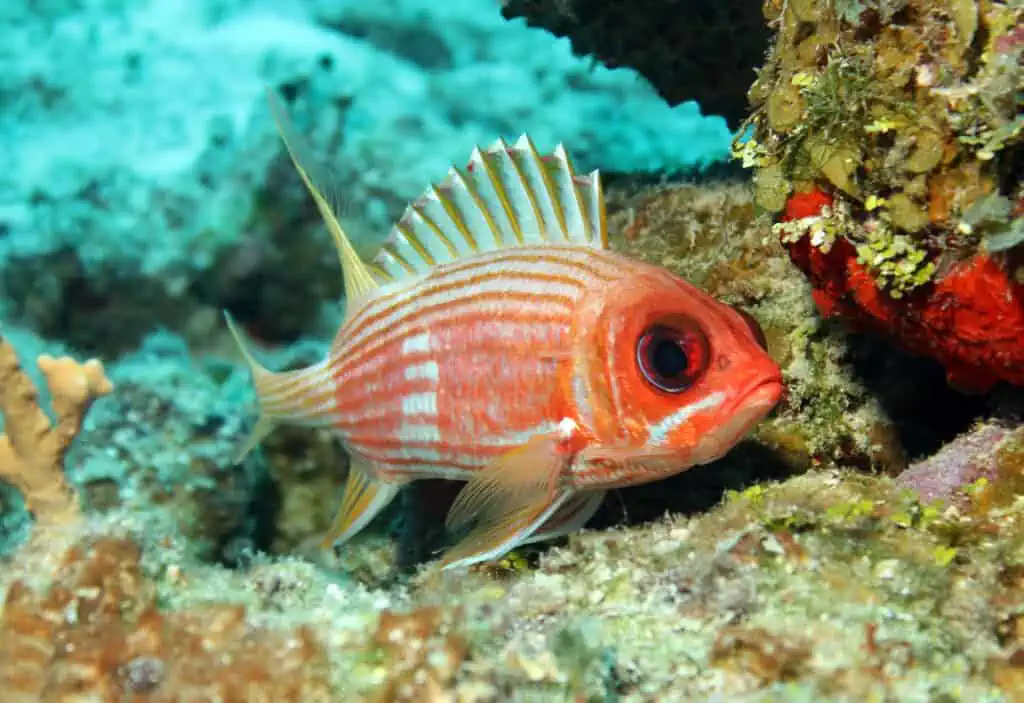There are many species of fish to choose from, including many with quirky looks that are bound to catch the eye. Some have bright colors, fantastic fins, or strange body shapes; the choice for hobbyists is mindboggling!
In this guide, we introduce 14 types of fish that have bigger eyes than average.
Now, that’s sure to make you look twice!
Aquarium Fish With Big Eyes
When deciding what fish to add to your collection, remember that many of these species have specific care requirements, including diet, compatibility with other fish, and tank conditions. So, thoroughly research each species before you part with your hard-earned cash and bring the fish home.
Bubble Eye Goldfish (Carassius auratus)
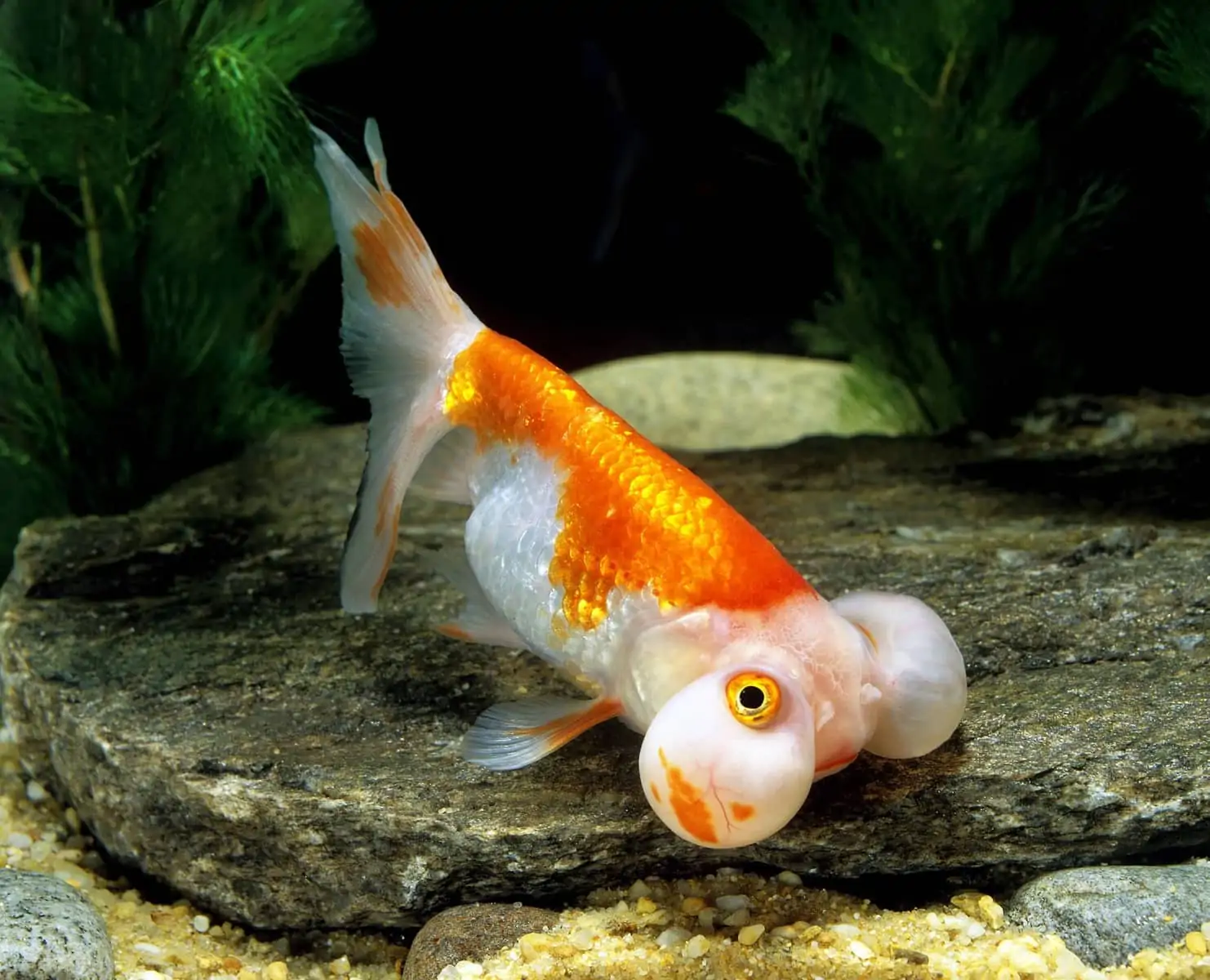
- Min tank size: 20 gallons
- Water temperature: 65 to 75°F (18 to 24°C)
- Size: Up to 6 inches
Bubble Eye goldfish are a variety of Fancy goldfish that have huge eyes! These adorable fish are relatively easy to keep, although you will need to keep on top of your tank maintenance tasks because these fish generate an awful lot of waste!
Bubble Eye goldfish are best kept with their own kind or with other slow-moving goldfish types, as their weird bubble eyes can be vulnerable to damage and injury.
Telescope Goldfish (Carassius auratus)
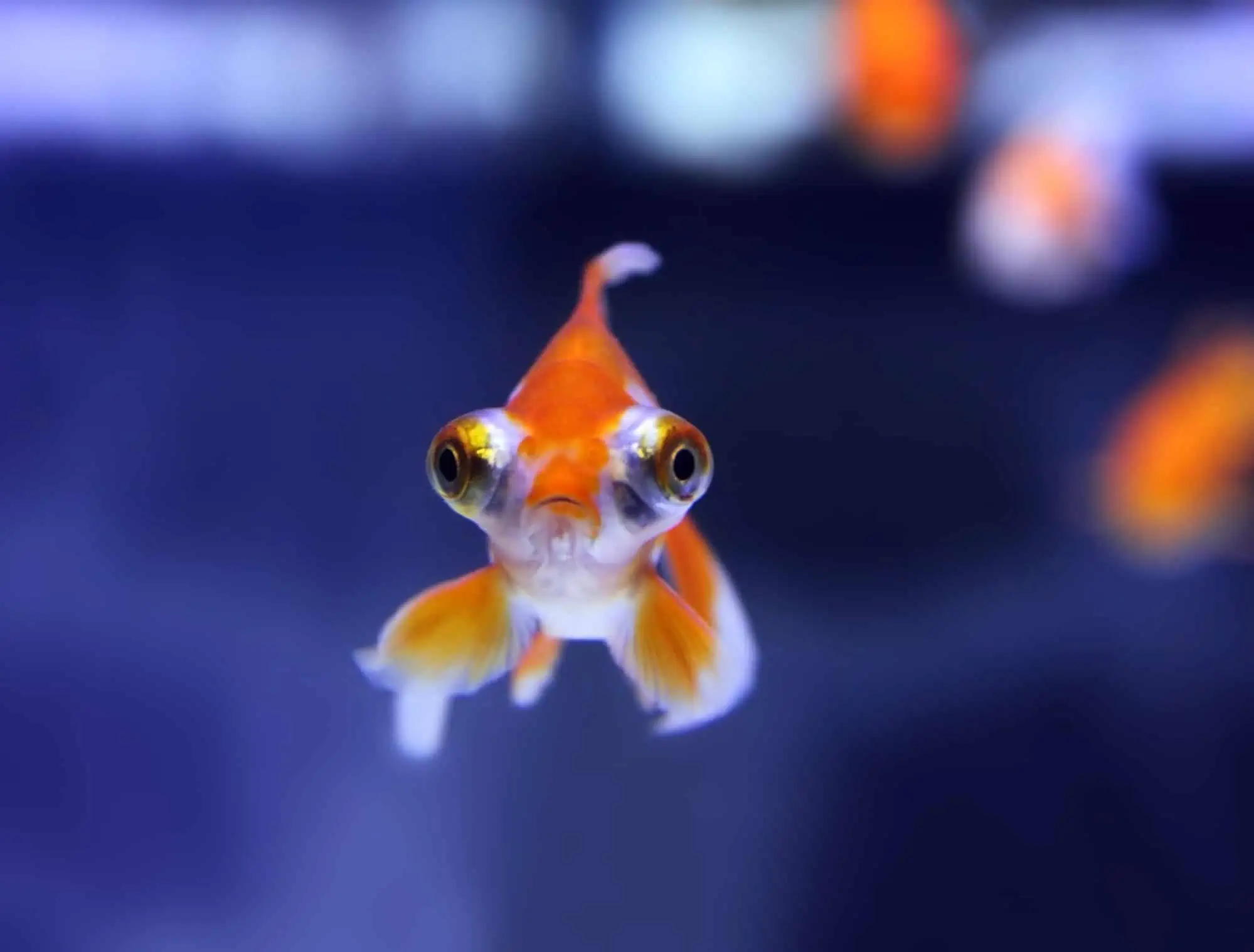
- Min tank size: 30 gallons
- Water temperature: 65 to 75°F (18 to 24°C)
- Size: Up to 8 inches
Telescope goldfish are another type of Fancy goldfish that have enormous, protruding eyes. These fish come in various colors, including black, silver, and white with orange markings. I once kept several of these gorgeous fish in my garden pond, and they thrived, even during cold winter weather.
These fish are pretty hardy and can live in an aquarium or outdoor pond with similar types of Fancy goldfish, although their large eyes can be prone to injury from collisions with tank mates and sharp decorations.
Celestial Eye Goldfish (Carassius auratus)
- Min tank size: 30 gallons
- Water temperature: 65 to 75°F (18 to 24°C)
- Size: Up to 8 inches
Celestial Eye goldfish, also known as the Choutengan, is a double-tailed Fancy goldfish variety with unique, upturned telescope eyes.
Keep these fish with others of their own kind in a tank without sharp or rough ornaments that could damage the fish’s eyes. One problem with keeping these fish is that they can miss out at feeding times since their poor eyesight makes them very slow swimmers and sometimes arrive too late to the party.
Black Moor Goldfish (Carassius auratus)

- Min tank size: 20 gallons
- Water temperature: 65 to 75°F (18 to 24°C)
- Size: Up to 6 inches
Black Moors are a type of Telescope Eye goldfish that can be a velvet black or bronze color. These friendly fish can be trained to eat from your hand and will follow your finger around the tank when you’re carrying out routine cleaning tasks.
Oranda Goldfish (Carassius auratus)

- Min tank size: 30 gallons
- Water temperature: 65 to 75°F (18 to 24°C)
- Size: Up to 8 inches
Oranda goldfish are a type of round-bodied Fancy goldfish that’s characterized by the fleshy structure on the head called a wen.
These popular fish can live in a community tank with other similar goldfish types. However, the Oranda’s wen sometimes grows so large that the fish’s large eyes are obscured, hindering swimming and causing problems at feeding time and when negotiating the aquarium.
Moorish Idol (Zanclus cornutus)

- Min tank size: 125 gallons
- Water temperature: 72 to 78°F (22 to 26°C)
- Size: Up to 9 inches
The Moorish Idol is a beautiful saltwater fish that needs to live in a group of its own kind in a large aquarium. These fish are compatible with most marine fish and large invertebrates, although they will eat corals, polyps, and small inverts.
Although these large-eyed fish make an elegant, graceful addition to any marine tank, they are notoriously difficult to feed in a captive environment and are recommended only for expert hobbyists.
Japanese Dragon Eel (Enchelycore pardalis)

- Min tank size: 50 gallons
- Water temperature: 74 to 80°F (23 to 27°C)
- Size: Up to 24 inches
Dragon eels are a beautiful species of saltwater fish having striking mottled black, orange, and white coloration, accented by horns and nostril flares above large eyes that give the animal a dragon-like appearance.
These eels need a tank with plenty of shelter in which to hide until acclimated and a tight-fitting lid to prevent escape. These fish are safe with corals, although they must be fed live feeder fish, octopus, and squid, and are not averse to making a meal of other fish in the tank.
Dragon Goby (Gobioides broussonnetii)
- Min tank size: 50 gallons
- Water temperature: 72 to 82°F (24 to 28°C)
- Size: Up to 12 inches
Dragon gobies are long-bodied bottom feeders that need a mature, brackish tank with soft sandy substrate in which they can bury themselves. These shy fish need plenty of hiding places, such as driftwood, rocky caves, and salt-tolerant plants.
This is generally a peaceful species, although it can be somewhat territorial with its own kind. For that reason, we recommend keeping only one of these large-eyed fish per tank.
Green Spotted Puffer (Tetraodon nigroviridis)
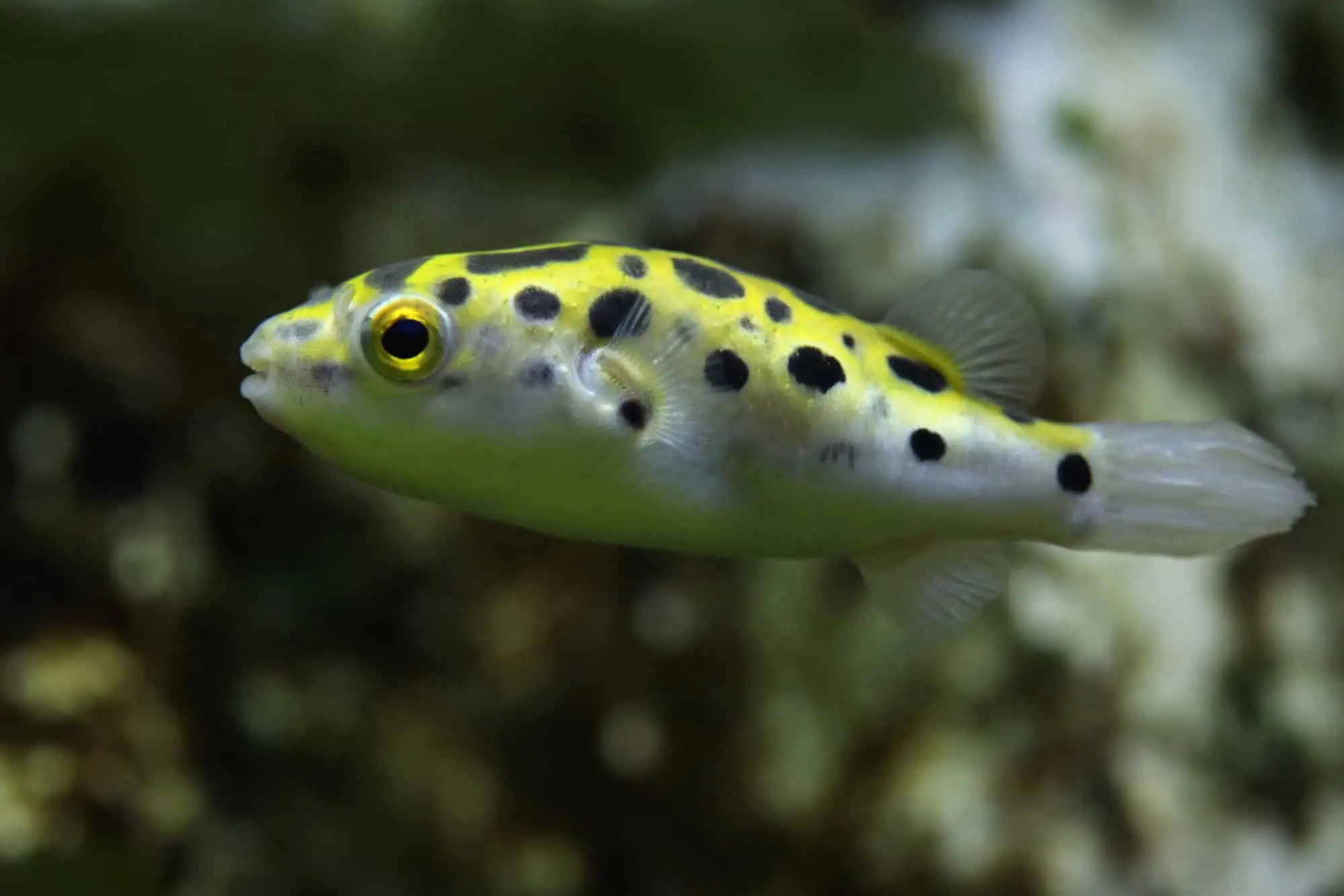
- Min tank size: 30 gallons
- Water temperature: 75 to 82°F (24 to 28°C)
- Size: Up to 6 inches
The Green Spotted pufferfish must live in a single-species brackish aquarium.
These quirky fish need a large tank, as they are rather aggressive, growing more belligerent as they reach adulthood, and if the tank is too small, the fish will bite each other forcefully. Never corner or frighten the Green Spotted pufferfish, as that can make them inflate, which can be fatal if the fish takes on too much air.
Longspine Squirrelfish (Holocentrus rufus)

- Min tank size: 200 gallons
- Water temperature: 73 to 84°F (23 to 29°C)
- Size: Up to 8 inches
The beautiful Longspine squirrelfish is one of around 150 different species of squirrelfish that live in the tropical waters of reefs in the Western Atlantic Ocean, including the Gulf of Mexico and the Caribbean Sea.
Squirrelfish are most often seen in public aquarium displays, where they are most well known for their large eyes and elongated third spine of the anal fin. These fish are territorial and use sounds like grunts and “staccatos” to defend their chosen crevice and intimidate predators like Moray eels.
The Longspine squirrelfish is edible and can sometimes be seen on restaurant menus!
Norman’s Lampeye Killifish (Poropanchax normani)
- Min tank size: 10 gallons
- Water temperature: 73 to 78°F (23 to 26°C)
- Size: 1.2 to 1.6 inches
The Norman’s Lampeye killifish is so-named for its huge eyes that take up over half the fish’s face and reflect a brilliant blue, appearing to glow like a lamp!
But the fish’s distinctive feature has a practical purpose. Firstly, those huge eyes enable these carnivorous fish to follow the tiny creatures they feed on and hunt, and their bodies are pale to make them less visible to predators.
Spotted Ratfish (Hydrolagus colliei)

- Min tank size: N/A
- Water temperature: 46 to 64°F (8 to 18°C)
- Size: Up to 24 inches
The Spotted Ratfish is a deep-sea species sometimes seen in large public aquariums but unsuitable for life in a home tank. These fish are named for their pointed, rodent-like tail and have huge eyes to help them navigate their deepwater habitat.
These fish live in the cold, oxygen-rich waters of the northeastern Pacific Ocean, ranging from Alaska to Baja California, typically inhabiting areas close to the continental slope or on the outer continental shelf.
Shell-Dwelling Cichlids
- Min tank size: 20 gallons
- Water temperature: 75 to 79°F (24 to 26°C)
- Size: Up to 2.5 inches
Shell-dwelling cichlids are fascinating creatures that are found in Lake Tanganyika along the coast of Zambia, Burundi, the Democratic Republic of Congo, and Tanzania.
There are many different species of shell dwellers that come in different sizes and colors, and they can make excellent aquarium pets. The unique fact about these cichlids is that they use empty snail shells for breeding purposes and for shelter.
Bigeye Fish (Priacanthidae)
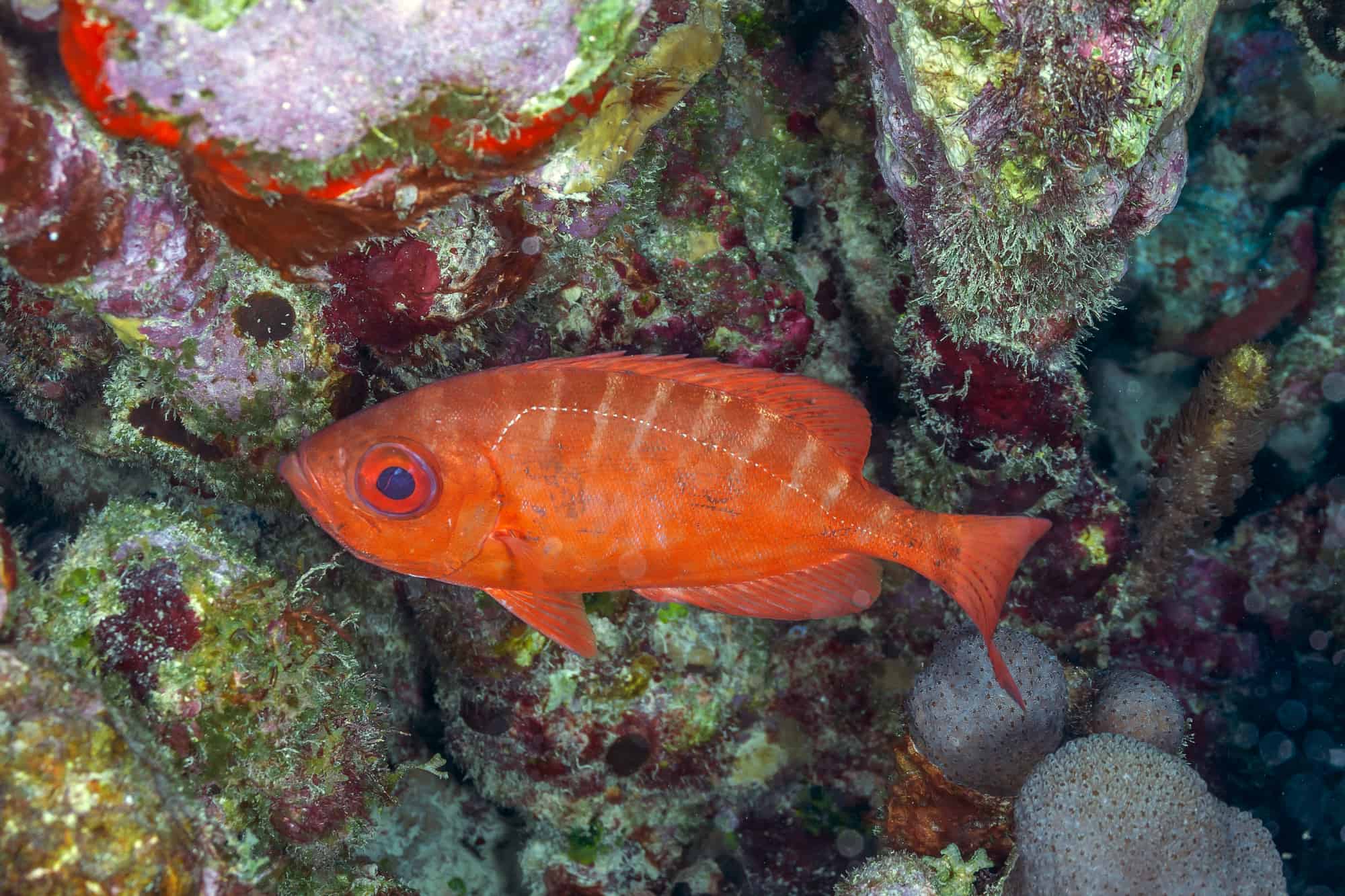
- Min tank size: N/A
- Water temperature: 68 to 86°F ( 20 to 30°C)
- Size: Up to 12 inches
Bigeye fish are deep-sea fish that inhabit the tropical and subtropical waters of the Indian and Pacific Oceans, although some species are found in the Atlantic. The fish live close to rocky outcrops or reefs, although some species live in open water, usually at depths beyond the reach of normal scuba diving.
These carnivorous, nocturnal fish have been around in our oceans for around 40 to 50 million years, according to fossils, and take their common name from their unusually large eyes.
Why Do Some Fish Species Have Large Eyes?
There are several reasons why certain fish species have unusually large eyes.
Enhanced Vision
Some fish species live in environments where the water is murky, or the lighting is poor, so they have evolved extra-large eyes to enable them to see better in dim light. That’s why many fish with big eyes come from deep-sea habitats where the sunlight barely penetrates.
Hunting Advantage
Many predatory fish species have large eyes to enable them to find prey more effectively. Large eyes give the fish a wider field of view and better depth perception, helping the fish to spot their prey from a greater distance.
Nocturnal Species
Nocturnal fish species are mainly active at night, and large eyes enable the fish to utilize what little light is available to find food and better navigate the darker waters of their natural environment.
Finding Prey
Fish that feed on very small organisms and plankton often have large eyes to increase their chances of spotting and catching tiny prey items.
Protection and Camouflage
In some deep-sea environments, such as coral reefs, the visual background is pretty complex, and some fish have evolved extra-large eyes as a means of camouflage or protection. Eyes that match the colors and patterns in which the fish live can help them to blend in seamlessly to avoid predators.
Do Bigger-Eyed Fish See Better Than Smaller-Eyed Fish?
Whether fish with big eyes can see better than their smaller-eyed cousins has been debated among hobbyists for many years.
One school of thought is that larger eyes automatically mean better vision, whereas others maintain that eye size is irrelevant when it comes to how well the fish can see.
Smaller-eyed Fish
Fish with small eyes usually have larger retinas relative to their body size, giving them greater light sensitivity than larger-eyed species.
That enables the fish to see distant objects in more detail but means they can’t see fine details in objects closer to them as clearly as fish with larger eyes because of their reduced resolution capacity.
Larger-eyed Fish
Larger-eyed fish species usually have wider fields of vision that enable them to detect movement from further away and increase their depth perception ability. That means these fish can more accurately judge distances between objects than their smaller-eyed counterparts.
In addition, these fish typically have higher visual acuity. That means they can discern patterns and shapes much more easily in low-light conditions, whereas fish with smaller eyes would struggle.
So, there might be some truth in the opinion that larger eyes provide visual advantages over smaller ones. However, all fish have evolved to survive and thrive in their natural environment regardless of what size eyes they have or their visual abilities.
How Do Fish Swim With Their Eyes Open?
Most fish species do not have eyelids, so they naturally swim and sleep with their eyes open.
If you think about it, fish don’t need eyelids like mammals do. Mammals have eyelids to keep their eyeballs moist and protected from dust and debris, but since fish live in an aquatic environment, fish eyes don’t need that same level of protection.
Final Thoughts
Did you enjoy our guide to 14 species of aquarium fish with big eyes? If you did, please take a moment to share the article with other fishy fans!
Some fish have large eyes to enable them to hunt and navigate their deep-water habitats more effectively, whereas other species use that physical quirk as camouflage. Whatever the reason a fish has larger-than-average eyes, we think they look cool!
What’s your favorite fish species with big eyes? Tell us in the comments box below!

